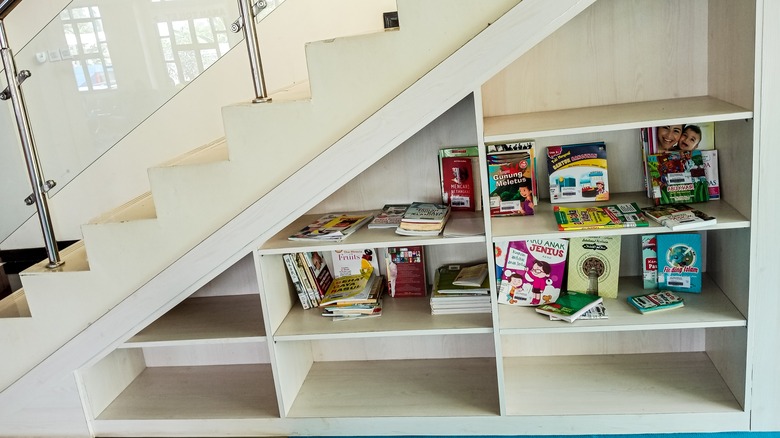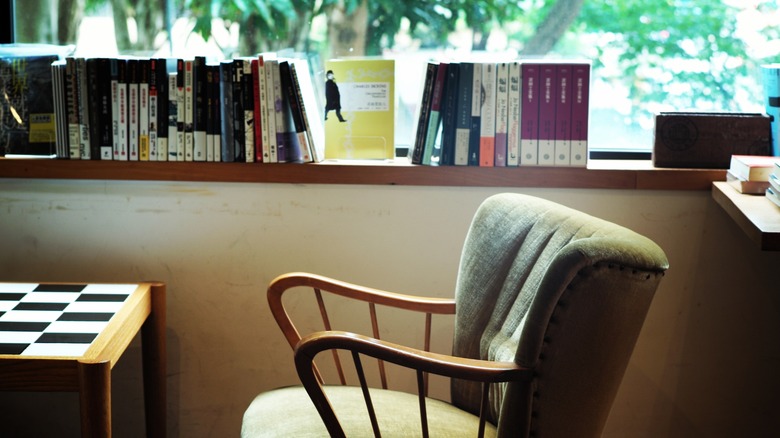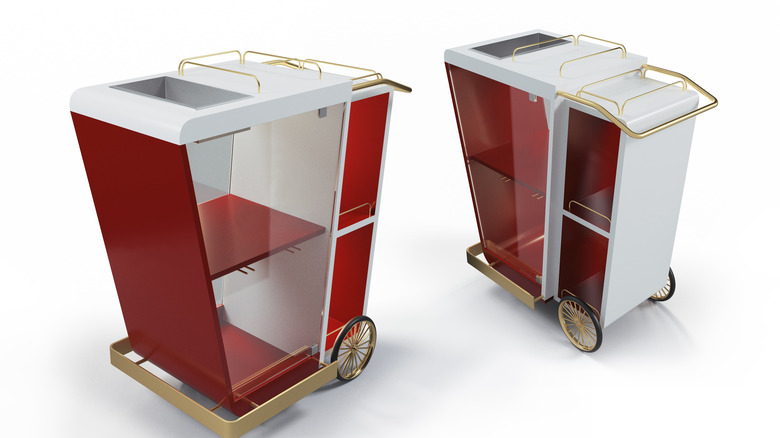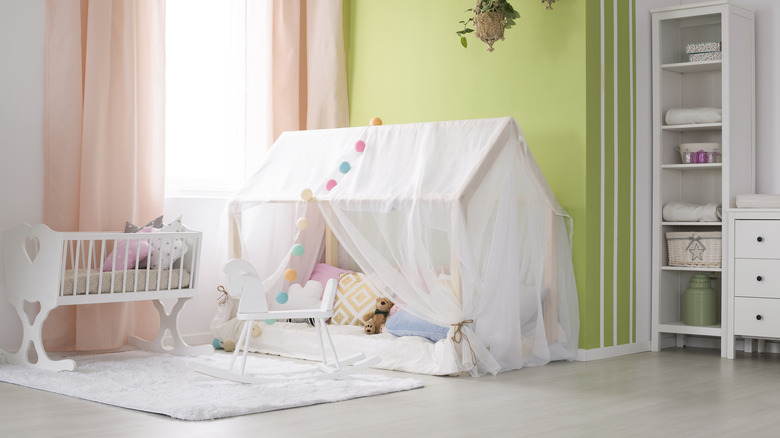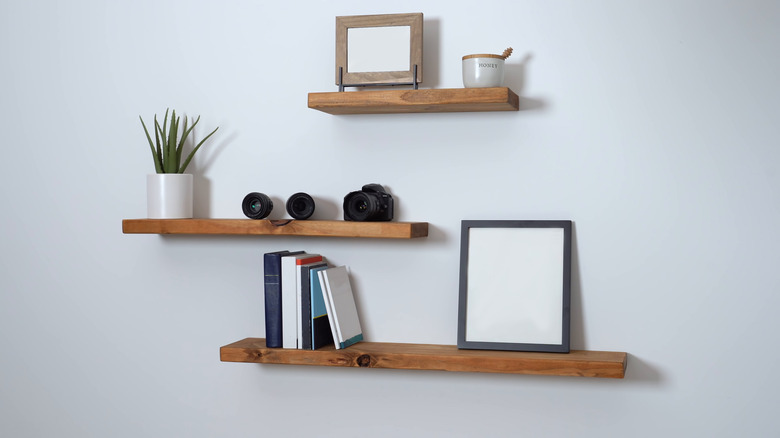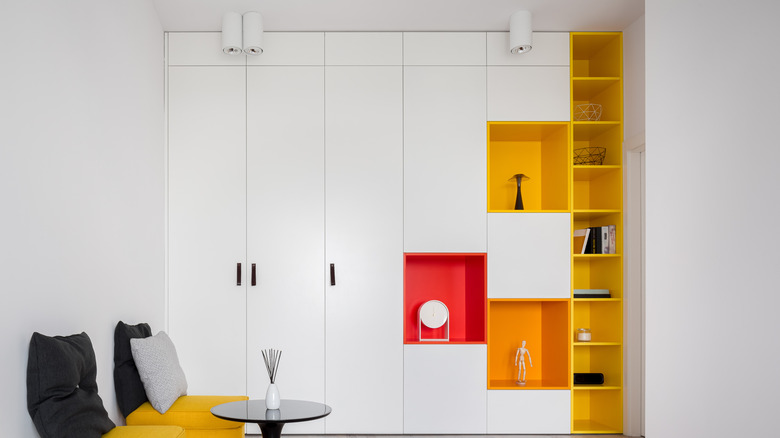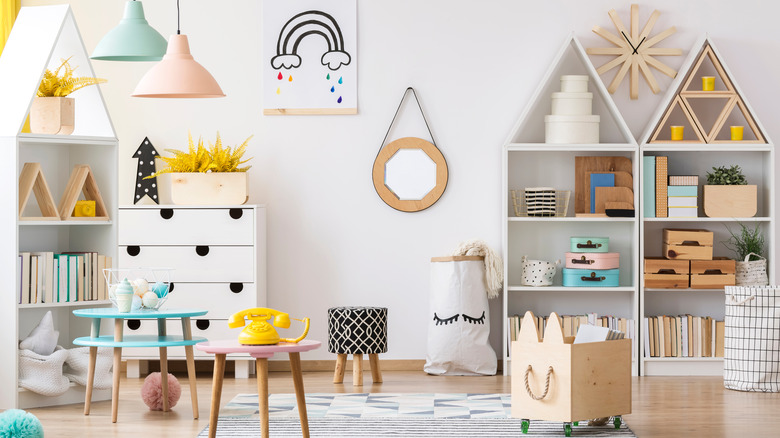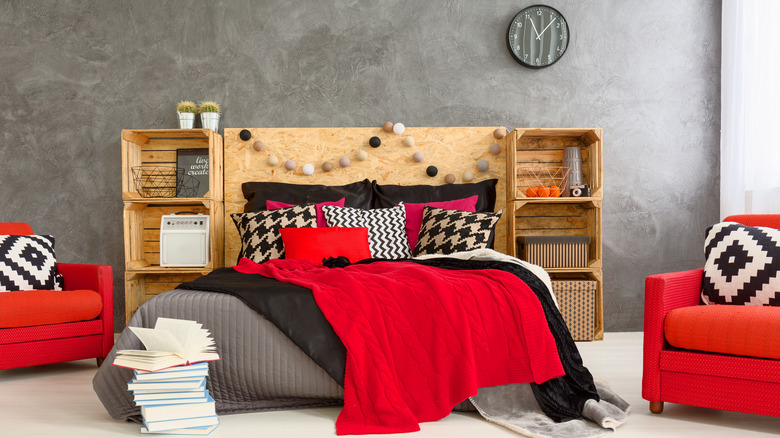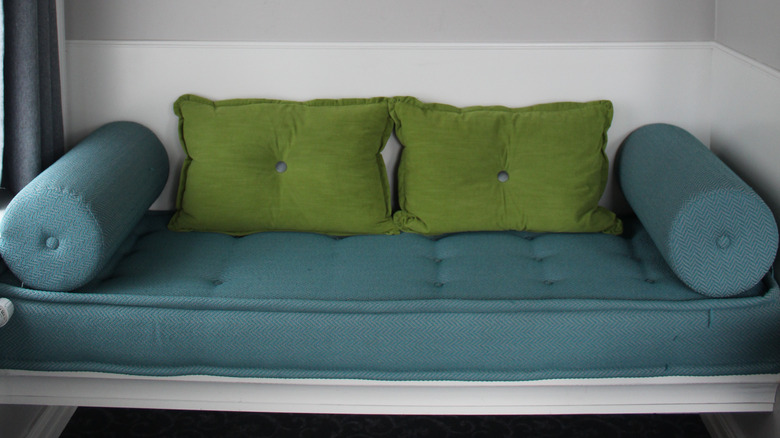Ways To Make A Reading Nook With Limited Spacing
While technology such as tablets and smartphones have taken over all aspects of our lives, there's nothing better than snuggling in a warm blanket with a cup of tea to read a juicy novel. Many people love to read books and have their own specific space for reading in their home called a reading nook. According to Beauty Harmony Life, having a reading nook enables children to read more comfortably. It's suggested that parents create a space that has engaging and age-appropriate books that'll grab their interest. By doing this, reading will become a habit and develop a child's literacy skills.
To make a reading nook more aesthetically pleasing, board books and picture books should be facing outward on an upward-standing shelf for young children (via Home Literacy Blueprint). Older children could do with bins of books organized by genre and title. When creating a makeshift reading area, be sure to at least have adequate lighting. While having limited space to construct a full-blown reading nook may be frustrating, it's still possible to make an area that'll fit into your lifestyle by utilizing storage items and furniture accessories. Be creative by making the space yours and consider these suggestions.
Create a space underneath a stairwell
Ever wonder what to do with underutilized space underneath a stairwell at home? Make a cozy resting space for reading, suggests Julie Blanner. Measure the area to make sure a comfortable mattress could fit under the stairwell. Place warm, textured blankets for added design and arrange decorative throw pillows on top of the mattress. Installing lights may be another idea for making the space more conducive. Check out local hardware stores for stringed lights or pendant lamps that could be installed with a few electrical adjustments.
Construct a storage bench to have underneath a stairwell (via Zac Jones on YouTube). A bench like this not only provides seating, but also supplies ample storage space beneath it for storing books, either in stacks or organized into bins. Beautify the area by painting to whatever color is your desired preference. If you're not the handy type, you can measure your space and shop around for pre-made benches that will fit in the space beneath the stairs.
Place books on or beneath windowsills
According to Complete Window Care, a no-fuss way to create a reading nook would be to put books on top of a windowsill or organize them beneath a window. This could be accomplished with windows of any size or style, but long windows that aren't too high work the best. Take a cushioned bench and push it up against the window. Check out local bedding and furniture stores to purchase portable bookshelves that could be moved around and adjusted easily.
Decorate the space around the window by placing framed photos of family and friends on top of the windowsill. For those who enjoy having greenery in their home, place potted faux plants along the top of the windowsill. Go with the idea of media entertainment by tacking book, movie, or television show-related posters on the walls. Be creative by establishing a theme. Think cozy, bedtime feelings by placing twinkle lights around the windows, cloud-shaped novelty pillows on the windowsill, and overstuffed metallic cosmic blue bean bags on the floor. Children may like a zoo reading nook theme by having stuffed elephants, lions, and giraffes standing guard on the windowsill. Paste zoo animal decals on the walls, or paint zoo animals on the portable bookshelves or the windowsill itself.
Bring out a rolling cart
Who wouldn't want to have their favorite books on hand each day? Construct a portable reading nook to transport your favorite series to any room in the home, as demonstrated by The Home Depot on YouTube. Take three two-by-four pieces of plywood to screw 16 inches apart on two pieces of plywood that measure 33 inches wide on top and 17 ¼ inches in length. Use two self-tapping screws per side. You'll need to make two of these shelf pieces.
Get started on the shelves by using wood glue to attach two one-by-three pieces of wood to the right and left sides of a piece of plywood measuring 49 ½ inches long. Glue two pieces of plywood measuring 15 ¾ inches wide on top and bottom. Besides using glue, make sure the ends are secure with 1 ¼-inch finish nails. After making three of these pieces, lay them facing down and attach the shelves with two-inch wood screws. Use two screws per shelf end. Attach caster wheels with screws to the bottom ends of the cart.
Rather than making a rolling cart for books, you might want to purchase this Ameriwood Home Marshall 3-Shelf Metal Rolling Utility Cart in Teal from Amazon. Decorate the rolling cart by wrapping ribbon or tinsel along the sides for a festive effect. The rolling cart shouldn't be overloaded with books and kept light in weight. When not in use, keep the rolling cart in a safe area.
Make a canopy
Create a simple canopy as a reading nook space, as demonstrated by Roxy James on YouTube. Take a hula hoop and cut the middle, or unlatch the part where the two pieces meet. Gather a curtain that has an opening to slide the hula hoop through. Move the curtain around on the hula hoop to ensure that it fits well. Find four long pieces of tulle or ribbon to tie around the hula hoop. Take the four pieces and tie them above the hoop in the middle. Hang the canopy on a hook installed on the ceiling. Place a blanket and throw pillows inside the canopied space. The canopy could fit in the living room, bedroom, or den.
To personalize the canopy, add small bookshelves around the area. If that doesn't work, buy containers from a home store to place books in when the time is right for reading. Decorate the canopy as well by sewing iron-on patches featuring unique characters. Purchase frilly or silky throw pillow covers to change out the look of your pillows when desired.
Install a hammock
Bring the outdoors inside by having a hammock in the house to relax while reading. Limbo Imports notes that school-aged children could benefit from doing homework and reading on a hammock to enhance their focus. The constant motion of swinging increases blood flow to the brain which helps children better pay attention to the task at hand. Children may also see an improvement in their school performance and testing by concentrating and feeling relaxed swinging on a hammock.
Adults can enjoy reading hammocks for the same benefits as children as well. Find a spot in the living room to install a hammock. Place the hammock where furniture and priceless home accessories won't be disturbed. Keep a few good books nearby. Spruce up the hammock by matching it to the aesthetic of the home or living room, or do your own theme. Love oceanic décor? Place a few nautical anchor printed pillows on the hammock with striped navy blue and white cushioned seats. Go the bohemian route by placing texturized pillows with tasseled details on top of the hammock. Try out this Junior Classic White Hammock Chair Swing on Limbo Imports.
Add floating shelves on home walls
An effortless way to establish reading nook space would be to install floating shelves on walls, as noted by iScaper1 on YouTube. Most floating shelf sets come in a pack of two or three with screws. Decide what wall to have the floating shelves installed on. Use a stud finder to find a wall stud, and mark where you'd like to install your shelves with a pencil. Install the shelf hardware by screwing it into the spots you marked on the wall. Place a few books on each shelf, but follow the manual instructions on weight capacity to prevent breakage.
Check out this Floating Shelf by Wayfair. Floating shelves could be placed on the walls of an office, a bedroom, or a kitchen. Be unique by making floating shelves look invisible by painting them to match the walls you want them situated on. Stay with a particular genre of books to keep on the floating shelves and decorate around the shelves based on genre to be cohesive. Love mysteries? Place whodunnit novels on the shelves with a hanging magnifying glass as décor on the walls. Fancy romantic novels? Keep a few love stories on floating shelves beside porcelain heart accessories.
Utilize closet space
Have an unused closet that needs to be remodeled? Why not turn the closet into a reading nook? Before beginning on the project, decide on which closet to remodel, advises Book Riot. Paint the walls of the closet, or change the wallpaper for embellishment. Remove doors to give open space, especially if the doors are broken or not in style. Hire an electrician to install lighting in the closet. If room allows, try to fit a comfortable bench inside of the closet by constructing one by hand, or purchasing one from a home and furniture store. Don't neglect comfort — be sure to add plenty of cushions and pillows. Blankets and quilts on top of benches are another way to introduce coziness. Plaques featuring book and author-related art could be hung on closet walls.
Before making any changes to create a closet DIY reading nook, take out old storage items that don't need to be there (via Repurpose & Upcycle). If old items need to stay on top of a closet's shelf, hang a valance above the closet opening to hide clutter. Incorporate book space by putting a few shelves on one side of the closet's walls. Be fancy by hanging a crystal chandelier on the closet ceiling. For a cutesy effect, place character bean bags inside the closet, such as animals or make-believe beings such as mermaids or unicorns. This is perfect for a reading nook for children — they'll be excited about reading and using this cozy area.
Make book space for children in their bedroom or playroom
Parents can create a specific reading area for children to help them develop their love of reading. Bedrooms, playrooms, or the living room are all perfect spots for a child's reading nook, according to Motherly. Children should have reading space in a spot where natural lighting is prevalent, such as around a bay window. Put pillows underneath for a place to sit while reading. Be unique by setting up a tent or fort for a reading shelter. Change out books every few weeks, or at least once a month so children have new books to look forward to.
Carve out a specific reading space in a playroom by decorating a wall with painted wooden craft letters that spell "READ," or other book-inspired slogans (via Crafts By Courtney). Use command strips to keep the letters in place. Beneath the crafted words, attach a couple of classic picture books inside colorful frames onto the wall. Install picture ledges beneath the framed books to keep storybooks intact. Place an appropriately sized toddler table and chairs below the picture ledges. This will enable children to sit quietly and have their books within easy reach.
Use floor space
Find unused floor space in the home to create a reading nook. Try to find an area where you can focus without having to deal with too many distractions. This could be an office or an unused extra bedroom. Try to find space in a room that has a soft carpet or a comfortable area rug. Hard wooden floors make sitting down to read uncomfortable. Make some space on the floor by gathering cushions, blankets, or pillows to be comfortable. Be sure to keep a pile of books nearby, and have proper lighting so as not to strain your eyes while reading.
Find a corner in a room with natural window lighting to put down a floor pillow while reading, such as this Rainha – Ultra Thick Tufted Floor Pillow from Overstock. There's enough room to lie down and get comfy while you read. Prop up a pillow and consider adding a cozy blanket while you're at it. Use this to sit down on a floor to read, or create a bed of sorts with pillows and a body mat to relax and get lost within the pages of a delightful book.
Try a bookcase headboard
You have to have a headboard, so why not make it functional? If you enjoy reading in bed, a bookshelf headboard is a perfect idea for a reading nook that's comfortable, useful, and decorative, as shown by Architecture Art Designs. The great thing about this idea is that you don't really have to do anything special to make it work: Find a bookcase (either newly-purchased or one you can re-purpose from elsewhere in your home), pull your bed away from the wall, place the bookcase at the head of the bed, and then push your bed back into place. Or, if you have the space, you can leave your bed pushed against the wall and arrange bookcases on either side, flanking the bed. These side shelves could also double as built-in nightstands.
Once you have your bookcases arranged the way you want them, it's time to fill them! The shelves can display your books, collectibles, houseplants, or photos. You can even buy clip-on lamps to attach to the shelves so you can have light right where you need it.
Turn part of the basement into a reading nook
Tired of looking at an unfinished basement, and wish that it had some lively décor and furniture where family members could read? Create a reading nook in a basement, as noted by Storytellers Cottage. Measure space on one side of the basement. The space needs to be big enough to handle a hollow platform as well as bookshelves. Build the hollow platform across the bottom of the area with wood. Build three compartments on the platform with the first and the third spots having drawers to place children's toys and games in. The middle second compartment could remain open for easy access to books. Build two outer bookshelves next to the platform while building two bookshelves inside and above the platform with wood.
Paint the bookshelves and platform a soft, neutral color like ivory. Painting the bookshelves and wood a light color will enhance feelings of coziness and feel welcoming. For extra design, install a brass curtain rod above the platform and place curtains on the rod. The curtains will provide additional privacy when closed. Try to fit a bed or cot inside on top of the platform. Grab comfortable bedding and toss throw pillows on top of the bed. Install a few ceiling lights for adequate lighting. Making a book nook doesn't have to be difficult. Etching out proper space in a room, gathering comfortable items, and having space to store books are all you need.

